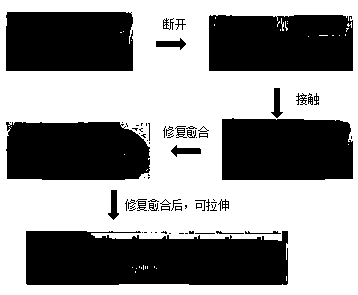Organosilicon polyethylene glycol hydrogel material with self-healing characteristic and preparation method thereof
A polyethylene glycol and organosilicon technology, which is applied in the field of organosilicon hydrogels, can solve the problems of high preparation cost, poor self-healing performance, and inconvenient preparation methods, and achieves simple preparation process, low cost and environmentally friendly preparation, good biocompatibility
- Summary
- Abstract
- Description
- Claims
- Application Information
AI Technical Summary
Problems solved by technology
Method used
Image
Examples
Embodiment 1
[0044] (1) Preparation of reaction solution
[0045] Disperse amino silicone oil (average molecular weight 80000g / mol, ammonia value 0.6) in deionized water to obtain an aqueous solution of component A amino silicone oil with a mass percent concentration of 6%; amino-terminated polyethylene glycol (average molecular weight 2000g / mol) was dissolved in deionized water to obtain an aqueous solution of amino-terminated polyethylene glycol of component B with a mass percent concentration of 5%; N,N'-thiocarbonyldiimidazole was dissolved in deionized water to obtain a mass percent concentration 8% C component N,N'-thiocarbonyldiimidazole aqueous solution;
[0046] Wherein, the structural formula of amino-terminated polyethylene glycol aqueous solution is:
[0047]
[0048] (2) Preparation of pre-polymerization solution
[0049] Mix 100g of component B and 800g of component C, stir evenly, and react at 60°C for 2 hours to obtain a prepolymer solution;
[0050] (3) Preparation ...
Embodiment 2
[0055] (1) Preparation of reaction solution
[0056] Disperse amino silicone oil (average molecular weight 20000g / mol, ammonia value 1.0) in deionized water to obtain an aqueous solution of component A amino silicone oil with a mass percent concentration of 2%; amino-terminated polyethylene glycol (average molecular weight 6000g / mol) was dissolved in deionized water to obtain an aqueous solution of amino-terminated polyethylene glycol of component B with a mass percentage concentration of 4%; N,N'-thiocarbonyldiimidazole was dissolved in deionized water to obtain a mass percentage concentration 8% C component N,N'-thiocarbonyldiimidazole aqueous solution;
[0057] Wherein, the structural formula of amino-terminated polyethylene glycol aqueous solution is:
[0058]
[0059] (2) Preparation of pre-polymerization solution
[0060] Mix 100g of component B and 6g of component C, stir evenly, and react at 40°C for 5h to obtain a prepolymer solution;
[0061] (3) Preparation o...
Embodiment 3
[0066] (1) Preparation of reaction solution
[0067] Disperse amino silicone oil (average molecular weight 100000g / mol, ammonia value 0.3) in deionized water to obtain an aqueous solution of component A amino silicone oil with a mass percent concentration of 30%; amino-terminated polyethylene glycol (average molecular weight 800g / mol) was dissolved in deionized water to obtain an aqueous solution of amino-terminated polyethylene glycol of component B with a mass percent concentration of 1%; N,N'-thiocarbonyldiimidazole was dissolved in deionized water to obtain a mass percent concentration 5% aqueous solution of component C N,N'-thiocarbonyldiimidazole;
[0068] Wherein, the structural formula of amino-terminated polyethylene glycol aqueous solution is:
[0069]
[0070] (2) Preparation of pre-polymerization solution
[0071] Mix 100g of component B and 20g of component C, stir evenly, and react at 30°C for 8 hours to obtain a prepolymer solution;
[0072] (3) Preparati...
PUM
| Property | Measurement | Unit |
|---|---|---|
| Average molecular weight | aaaaa | aaaaa |
Abstract
Description
Claims
Application Information
 Login to View More
Login to View More - R&D
- Intellectual Property
- Life Sciences
- Materials
- Tech Scout
- Unparalleled Data Quality
- Higher Quality Content
- 60% Fewer Hallucinations
Browse by: Latest US Patents, China's latest patents, Technical Efficacy Thesaurus, Application Domain, Technology Topic, Popular Technical Reports.
© 2025 PatSnap. All rights reserved.Legal|Privacy policy|Modern Slavery Act Transparency Statement|Sitemap|About US| Contact US: help@patsnap.com



